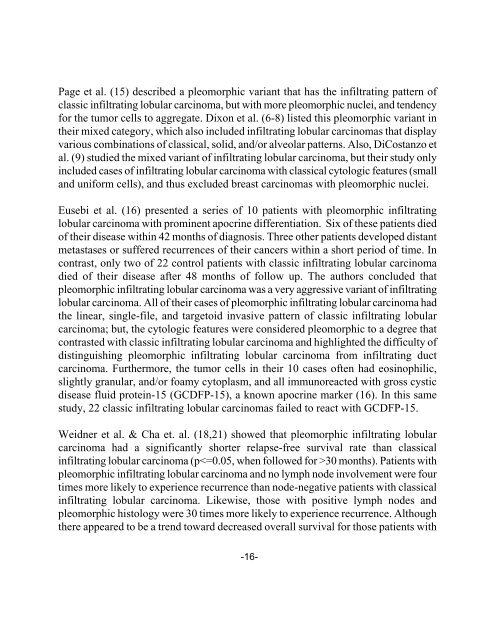33 Special Types of Invasive Breast Carcinoma: Diagnostic Criteria ...
33 Special Types of Invasive Breast Carcinoma: Diagnostic Criteria ...
33 Special Types of Invasive Breast Carcinoma: Diagnostic Criteria ...
You also want an ePaper? Increase the reach of your titles
YUMPU automatically turns print PDFs into web optimized ePapers that Google loves.
Page et al. (15) described a pleomorphic variant that has the infiltrating pattern <strong>of</strong><br />
classic infiltrating lobular carcinoma, but with more pleomorphic nuclei, and tendency<br />
for the tumor cells to aggregate. Dixon et al. (6-8) listed this pleomorphic variant in<br />
their mixed category, which also included infiltrating lobular carcinomas that display<br />
various combinations <strong>of</strong> classical, solid, and/or alveolar patterns. Also, DiCostanzo et<br />
al. (9) studied the mixed variant <strong>of</strong> infiltrating lobular carcinoma, but their study only<br />
included cases <strong>of</strong> infiltrating lobular carcinoma with classical cytologic features (small<br />
and uniform cells), and thus excluded breast carcinomas with pleomorphic nuclei.<br />
Eusebi et al. (16) presented a series <strong>of</strong> 10 patients with pleomorphic infiltrating<br />
lobular carcinoma with prominent apocrine differentiation. Six <strong>of</strong> these patients died<br />
<strong>of</strong> their disease within 42 months <strong>of</strong> diagnosis. Three other patients developed distant<br />
metastases or suffered recurrences <strong>of</strong> their cancers within a short period <strong>of</strong> time. In<br />
contrast, only two <strong>of</strong> 22 control patients with classic infiltrating lobular carcinoma<br />
died <strong>of</strong> their disease after 48 months <strong>of</strong> follow up. The authors concluded that<br />
pleomorphic infiltrating lobular carcinoma was a very aggressive variant <strong>of</strong> infiltrating<br />
lobular carcinoma. All <strong>of</strong> their cases <strong>of</strong> pleomorphic infiltrating lobular carcinoma had<br />
the linear, single-file, and targetoid invasive pattern <strong>of</strong> classic infiltrating lobular<br />
carcinoma; but, the cytologic features were considered pleomorphic to a degree that<br />
contrasted with classic infiltrating lobular carcinoma and highlighted the difficulty <strong>of</strong><br />
distinguishing pleomorphic infiltrating lobular carcinoma from infiltrating duct<br />
carcinoma. Furthermore, the tumor cells in their 10 cases <strong>of</strong>ten had eosinophilic,<br />
slightly granular, and/or foamy cytoplasm, and all immunoreacted with gross cystic<br />
disease fluid protein-15 (GCDFP-15), a known apocrine marker (16). In this same<br />
study, 22 classic infiltrating lobular carcinomas failed to react with GCDFP-15.<br />
Weidner et al. & Cha et. al. (18,21) showed that pleomorphic infiltrating lobular<br />
carcinoma had a significantly shorter relapse-free survival rate than classical<br />
infiltrating lobular carcinoma (p30 months). Patients with<br />
pleomorphic infiltrating lobular carcinoma and no lymph node involvement were four<br />
times more likely to experience recurrence than node-negative patients with classical<br />
infiltrating lobular carcinoma. Likewise, those with positive lymph nodes and<br />
pleomorphic histology were 30 times more likely to experience recurrence. Although<br />
there appeared to be a trend toward decreased overall survival for those patients with<br />
-16-


